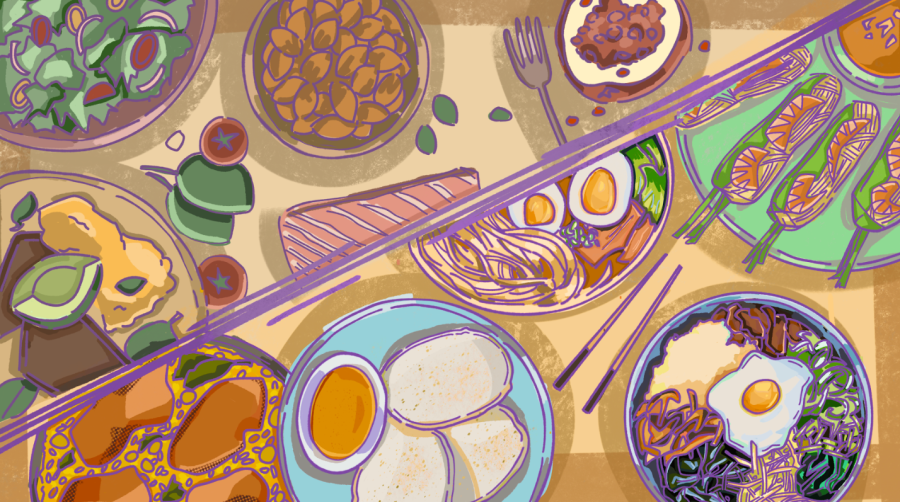Analyzing cultural diets in relation to healthy eating
DIVERSITY IS DELICIOUS: Cultural foods and healthy eating are not only delectable and comforting but can hold the same nutritional value as the normalized Western diet.
April 11, 2023
A quick Google search for “healthy foods” or “healthy recipes” will yield a variety of food choices including recipes for roasted vegetables and potatoes, kale smoothies, grilled chicken, a variety of pastas and the occasional healthy twist on tacos. However, these recipes only reflect the Western perception of healthy eating, with recipes lacking ethnic diversity and rarely being written by a person of color. Even when thinking of what healthy eating means, we often associate that with meals presented through a Eurocentric lens, disassociating non-Western cultural foods as “healthy” when in reality, cultural foods are just as nutritious, diverse and delicious.
Healthy eating, according to the CDC, means having “an array of colors to your plate,” including a variety of nutrients from dairy products, fruits, vegetables, proteins and grains, otherwise known as the five food groups illustrated in the USDA’s MyPlate. The idea of eating in accordance with MyPlate is an idea we were introduced to early on in life, setting the gold standard of healthy eating as half a plate of fruits and vegetables and half with grains and some form of protein. However, including just these five food groups in one’s diet isn’t possible for everyone, especially when it comes to accommodating cultural foods and dietary restrictions.
Cultural diets are a lot more diverse, with diets, such as the typical Indian plate, replacing the emphasis on meat with lentils and legumes to accommodate for the lower protein intake or a Japanese diet including more seafood. Growing up with a greater emphasis on lentils and rice, hearing comments like “where do you get your protein from?” or “you need to eat more meat so you won’t be so skinny” were common, shaping my own personal idea of healthy eating to take on that Eurocentric lens and confining my perception of the traditional foods cooked in my household to be less in nutritional value compared to having a plate of boiled broccoli and grilled chicken.
“Teaching about healthy eating should be about having a deep understanding of the way your patients eat, how they cook, their practices around preparing and serving food and any other details about their diets,” Registered Dietitian Nutritionist Tamara Melton said. “Placing foods on a good-bad binary is counterproductive and perpetuates toxic ways of thinking about food, also giving non-Eurocentric foods a bad rap.”
The issue isn’t that our cultural meals don’t look like what we see on MyPlate, but rather that fact that we are taught to externalize that Western eating habits are the only ways of eating healthy. Food that we consume is more than just fueling our body, it is also learning about our heritage, appreciating our ancestry and connecting with our family. So, when it comes to making healthier eating choices it is crucial to preserve those flavors or cultural choices you hold close to your heart.
The goal of healthy eating shouldn’t be to eat a certain way to achieve a certain physical goal but rather to find eating habits that make you feel the most nourished. This means not viewing meals from just a Western lens and not categorizing different foods as good or bad.


























































